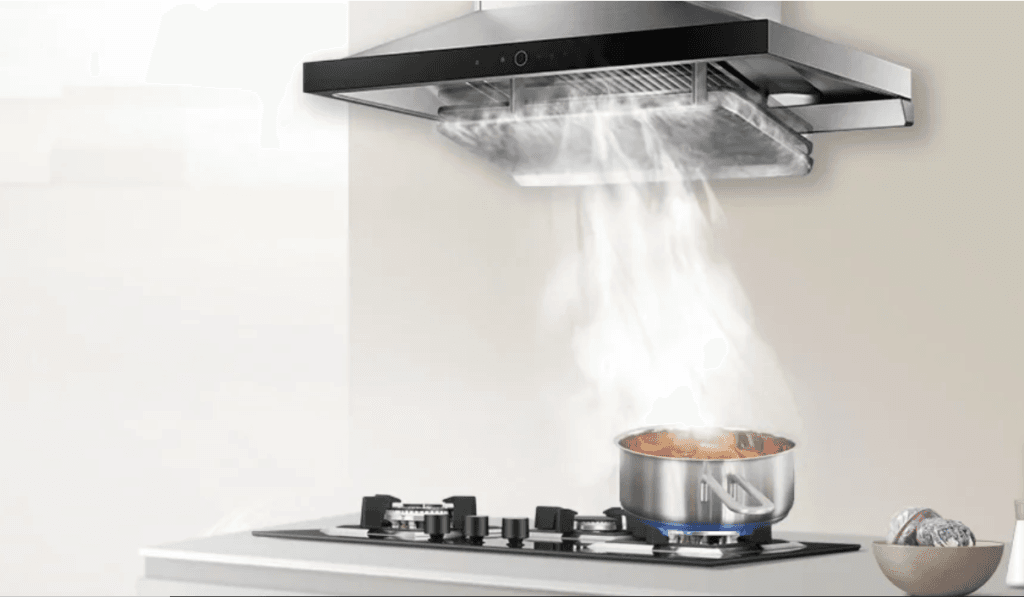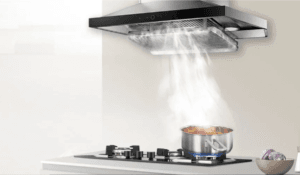What Does CFM Mean for Range Hoods? When shopping for a range hood, you may frequently come across the term CFM. This is an essential specification that determines the efficiency of the hood in maintaining good air quality in your kitchen. But what does CFM really mean, and why does it matter? Understanding this term will help you choose the right range hood for your cooking needs. In this article, we will explore the meaning of CFM, its importance, how to calculate the right CFM for your kitchen, and factors to consider when selecting a range hood. It can be energetic for you.
Understanding CFM in Range Hoods
CFM stands for Cubic Feet per Minute. It is a measurement of how much air the range hood can move within one minute. The higher the CFM, the more powerful the ventilation, meaning more air is removed from your kitchen, reducing smoke, grease, odors, and excess heat.
A range hood with a high CFM rating ensures that your cooking area remains fresh and free from unwanted particles. However, bigger is not always better. Choosing the right CFM based on your kitchen size and cooking style is crucial for efficient performance.

Why Is CFM Important for Range Hoods?
Selecting the correct CFM rating is essential for maintaining a comfortable and healthy kitchen environment. Here are some key reasons why CFM matters:
1. Improves Air Quality
Cooking produces smoke, grease, and steam, which can make the air unhealthy to breathe. A higher CFM ensures these pollutants are quickly removed, making your kitchen a safer and more pleasant place to cook.
2. Reduces Cooking Odors
Certain foods leave behind strong odors, such as fish, fried foods, and spices. An efficient range hood with the proper CFM can quickly eliminate lingering smells, keeping your kitchen and home fresh.
3. Controls Heat and Steam
Cooking generates heat and moisture, especially when using high-temperature cooking methods. A range hood with sufficient CFM helps control temperature by ventilating hot air, making your cooking experience more comfortable.
4. Prevents Grease Buildup
Grease particles can settle on kitchen surfaces, cabinets, and walls, creating a sticky mess. A powerful range hood with the right CFM efficiently removes grease from the air, reducing cleaning efforts and keeping your kitchen cleaner.
How to Determine the Right CFM for Your Range Hood
Choosing the right CFM depends on several factors, including the type of stove you have, your cooking habits, and kitchen size. Below are some general guidelines to help you calculate the right CFM for your range hood.
1. Based on Stove Type
- Electric Stove: Experts recommend a range hood with 100-150 CFM per linear foot of the cooktop. If you have a 30-inch electric cooktop, you need a range hood with at least 250-450 CFM.
- Gas Stove: Gas burners produce more heat, requiring higher ventilation. The rule of thumb is 100 CFM for every 10,000 BTUs of burner output. If your gas stove has 40,000 BTUs, you should choose a range hood with at least 400 CFM.
2. Based on Kitchen Size
The size of your kitchen also influences the required CFM. A larger kitchen requires more ventilation to maintain fresh air. You can calculate the necessary CFM using the following formula:
(Kitchen length x Kitchen width x Ceiling height) ÷ 4 = Required CFM
For example, if your kitchen measures 12 ft x 15 ft with an 8 ft ceiling:
(12 × 15 × 8) ÷ 4 = 360 CFM
This means you need a range hood with at least 360 CFM for adequate air circulation.
3. Cooking Habits and Frequency
If you cook frequently, especially with high heat, frying, or grilling, you may need a more powerful range hood. A higher CFM ensures quick removal of smoke and grease, preventing them from spreading throughout your home.
Factors to Consider When Choosing a Range Hoods

Apart from CFM, other important factors influence the efficiency of a range hood. Here are key aspects to consider:
1. Hood Mounting Style
Range hoods come in different styles, and their placement affects CFM requirements.
- Under-Cabinet Hoods: Mounted beneath kitchen cabinets, these hoods are compact but still require adequate CFM.
- Wall-Mounted Hoods: Installed on a wall above the stove, they need sufficient power for effective ventilation.
- Island Hoods: Suspended over an island cooktop, they require higher CFM due to open space around them.
- Downdraft Hoods: Installed behind or beside the cooktop, they pull air downward, requiring more CFM for efficiency.
2. Ducted vs. Ductless Hoods
- Ducted Hoods: Vent air outside, making them more efficient. They require proper duct installation to function well.
- Ductless Hoods: Use charcoal filters to clean the air before recirculating it back into the kitchen. These may require higher CFM for better performance.
3. Noise Levels
Higher CFM usually means louder operation. If noise is a concern, choose a hood with multiple fan speeds so you can adjust it as needed. Look for range hoods with quiet motors or sound-reducing features.
4. Energy Efficiency
A higher CFM means more power consumption. If energy efficiency is important, consider hoods with energy-saving motors and LED lighting.

Common Myths About CFM in Range Hoods
Many homeowners have misconceptions about CFM when buying a range hood. Let’s debunk some common myths:
1. Higher CFM Is Always Better
While a higher CFM improves ventilation, too much power can cause excessive noise and even pull conditioned air from your home, increasing energy costs.
2. Any Range Hood Works for All Stoves
Different cooking styles and stove types require specific CFM levels. A powerful gas stove needs more CFM than a small electric cooktop.
3. All CFM Ratings Are Accurate
Not all manufacturers provide precise CFM ratings. Always check customer reviews and product specifications to ensure the hood meets your needs.
Conclusion
Understanding CFM is crucial for selecting the right range hood for your kitchen. It determines how effectively your hood can remove smoke, grease, odors, and heat, keeping your cooking space comfortable and fresh. By considering your stove type, kitchen size, and cooking habits, you can choose the perfect CFM rating for your needs.
When purchasing a range hood, also consider factors like mounting style, ducting options, noise levels, and energy efficiency. A well-chosen range hood improves air quality and enhances your cooking experience. Invest wisely in a model that balances CFM, functionality, and convenience to create a healthier and more enjoyable kitchen environment.

